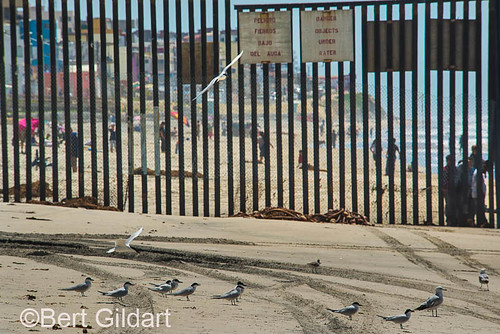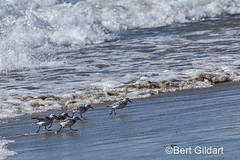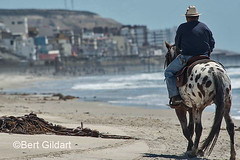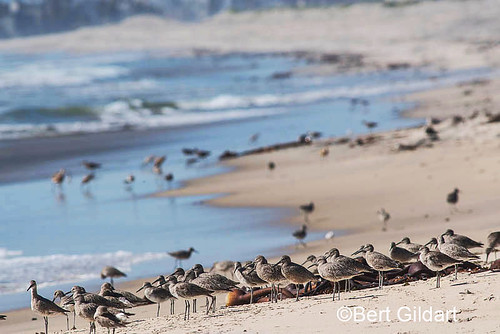San Diego – “Greatest Diversity of Wildlife in Continental U.S.”
©Bert Gildart: In the southwestern most part of the United States, there is a stretch of beach fed by the Tijuana River that empties into the Pacific Ocean. San Diego is situated toward one end of the beach while an International fence separating Mexico from the USA is situated at the other. To prevent illegal immigration one can see as he or she walks the beach several 4-wheel drive American Border Patrol vehicles whose drivers seems to monitor our every move. Helicopters fly overhead and the sound of their engines dominates the landscape. It’s a wild scene further dramatized by the overwhelming presence of the Pasa del Toro, a bull fighting ring that is part of Tijuana, Mexico and that seems to glare as one hikes the beach.

International fence separating Mexico from the U.S. On one side Mexican bathers enjoy surf while on the other Least Terns bask in protection afforded them by Border Field State Park
But there is also a different view one takes from the setting, a more natural one. Overhead, squadrons of brown pelicans wheel in a clear blue sky, while along the shoreline dozens of birds brave powerful ocean waves. All the birds time their forays into the tidal zone – hoping their efforts will return an assortment of insects, worms, and crustaceans – before powerful waves engulf them. Included in this group are dozens of sanderlings, who scurry just ahead of waves that are measured not only in power but in miles. When the sanderlings sense a breaker’s approach they accelerate their tiny bodies on twig-like legs that are simply a blur. In this manner they escape what could be a watery fate.
The contrast between the artifacts of urbanization and the residuals of a wild America is intense, and in this setting it is preserved by Border Field State Park. But as I walk the beach I’m not sure just how closely I can approach the huge fence that separates the two countries. Nor am I sure what kind of a reaction Border Patrol agents will have when I erect my tripod and unpack my long 600mm lens. I don’t want them to mistake my caisson-appearing lens for a weapon, so I carefully tilt the setup in their direction.
L to R: Back dropped by San Diego, Don and Nancy Dennis stroll along the beach celebrated at Border Field State Park; sanderlings race ahead of pounding surf; “Tony”, a Mexican/American
horseman strikes out for recreational ride along beach — pointing toward Tijuana and international fence.
But not to worry, and I begin my passion of photography, trying to capture all the bird life that seems to huddle near the American side of the international fence. Near its base, undisturbed by Mexican bathers on the other side, rests a flock of Least Terns, which add to my tally of shore-dwelling birds.
The setting overwhelms me and I am simply amazed that this city of sour mesh graffiti, navy bases, and expansive bridges – all used by some 1.5 million people – can preserve such wildness. But it is one of the awakenings Janie and I have enjoyed as we have explored what I call the wild side (to include the famous zoo) of San Diego.
We hike on, waving at the folks on the Mexican side, and now at the men in their patrol cars. As well, we tally our San Diego bird list, concluding that it now numbers close to 30.
This day is simply a continuation of the wonders we’ve enjoyed as we’ve learned more about all that is protected by some of this city’s far-seeing fathers. In some ways this may be a form of “Noblesse oblige” — but I am starting to understand the compelling mandate, for San Diego is said to be home to the greatest diversity of wildlife found anywhere in the continental U.S.
Again, we walk on, continuing with our explorations.
———————————————-
AIRSTREAM TRAVELS ONE YEAR AGO:
———————————————-
BOOKS FOR SALE:
4th ed. Autographed by the Authors
Hiking Shenandoah National Park
 Hiking Shenandoah National Park is the 4th edition of a favorite guide book, created by Bert & Janie, a professional husband-wife journalism team. Lots of updates including more waterfall trails, updated descriptions of confusing trail junctions, and new color photographs. New text describes more of the park’s compelling natural history. Often the descriptions are personal as the Gildarts have hiked virtually every single park trail, sometimes repeatedly.
Hiking Shenandoah National Park is the 4th edition of a favorite guide book, created by Bert & Janie, a professional husband-wife journalism team. Lots of updates including more waterfall trails, updated descriptions of confusing trail junctions, and new color photographs. New text describes more of the park’s compelling natural history. Often the descriptions are personal as the Gildarts have hiked virtually every single park trail, sometimes repeatedly.
Big Sky Country is beautiful
Montana Icons: 50 Classic Symbols of the Treasure State
![]() Montana Icons is a book for lovers of the western vista. Features photographs of fifty famous landmarks from what many call the “Last Best Place.” The book will make you feel homesick for Montana even if you already live here. Bert Gildart’s varied careers in Montana (Bus driver on an Indian reservation, a teacher, backcountry ranger, as well as a newspaper reporter, and photographer) have given him a special view of Montana, which he shares in this book. Share the view; click here.
Montana Icons is a book for lovers of the western vista. Features photographs of fifty famous landmarks from what many call the “Last Best Place.” The book will make you feel homesick for Montana even if you already live here. Bert Gildart’s varied careers in Montana (Bus driver on an Indian reservation, a teacher, backcountry ranger, as well as a newspaper reporter, and photographer) have given him a special view of Montana, which he shares in this book. Share the view; click here.
$16.95 + Autographed Copy
What makes Glacier, Glacier?
Glacier Icons: 50 Classic Views of the Crown of the Continent
![]() Glacier Icons: What makes Glacier Park so special? In this book you can discover the story behind fifty of this park’s most amazing features. With this entertaining collection of photos, anecdotes and little known facts, Bert Gildart will be your backcountry guide. A former Glacier backcountry ranger turned writer/photographer, his hundreds of stories and images have appeared in literally dozens of periodicals including Time/Life, Smithsonian, and Field & Stream. Take a look at Glacier Icons
Glacier Icons: What makes Glacier Park so special? In this book you can discover the story behind fifty of this park’s most amazing features. With this entertaining collection of photos, anecdotes and little known facts, Bert Gildart will be your backcountry guide. A former Glacier backcountry ranger turned writer/photographer, his hundreds of stories and images have appeared in literally dozens of periodicals including Time/Life, Smithsonian, and Field & Stream. Take a look at Glacier Icons
$16.95 + Autographed Copy






May 4th, 2013 at 8:50 am
Hi Bert,
I’ve been working on my art/nature project and was hoping you could take a few minutes to check it out. I’d really appreciate and value your opinion. I was also wondering if you know specific people I might contact in the publishing industry.
Here is the link…
http://nanettelasalle.com/WildSide/Topanga%20book%204-28-13%20Comp.PDF
Thanks so much for your help and advice.
This spring has been very busy for Charlie and I. We were going to drive the Mojave Road but things fell through. Now it’s too hot! Maybe some time in the fall. Will you guys be out in the desert next season?
Hope you both are happy and healthy. It would be nice to see you someday soon.
Thanks again.
Cheers,
Nan La Salle & Charlie too